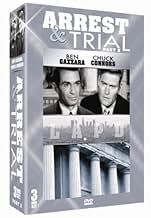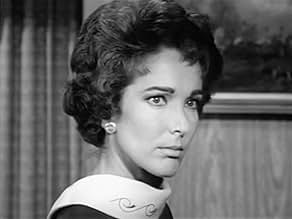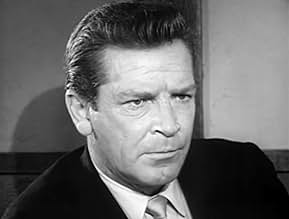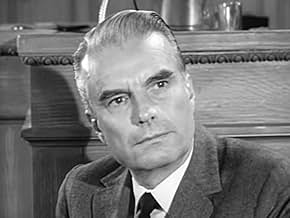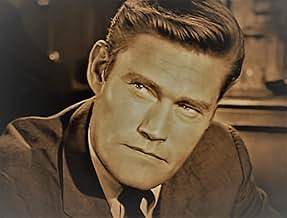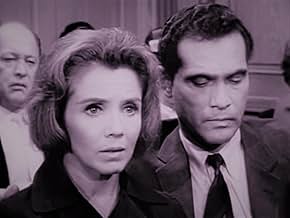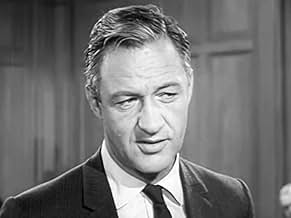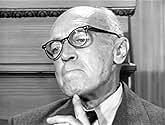Los Angeles est l'endroit où le sergent Nick Anderson et ses collègues travaillent pour assurer la sécurité des rues. Après l'arrestation de l'accusé, John Egan planifie sa défense, tandis q... Tout lireLos Angeles est l'endroit où le sergent Nick Anderson et ses collègues travaillent pour assurer la sécurité des rues. Après l'arrestation de l'accusé, John Egan planifie sa défense, tandis que l'accusation est dirigée par Jerry Miller.Los Angeles est l'endroit où le sergent Nick Anderson et ses collègues travaillent pour assurer la sécurité des rues. Après l'arrestation de l'accusé, John Egan planifie sa défense, tandis que l'accusation est dirigée par Jerry Miller.
- Nommé pour 4 prix Primetime Emmy
- 4 nominations au total
Parcourir les épisodes
Avis en vedette
Sometimes melodramatic, but intelligent and very well acted early 1960s U.S. TV series, that obviously served as the inspiration for "Law & Order".
Like "L & O" this is divided into 2 parts; "Arrest" where cop Ben Gazzara tracks down the person seemingly guilty of that week's crime and "Trial" where Chuck Connors defends them.
Having the 2nd half be from the defense point-of-view, not the prosecutor's makes the show different than "Law and Order", and arguably more interesting. It makes blatant how much of the legal system exists in shades of gray.
It's not surprising that Ben Gazzara is very, very good as cop Nick Anderson, making him more complex and interesting than your basic TV detective of the era. What caught me off- guard was that Connors as successful attorney John Egan, just about matches him. Unlike Gazzara, Connors was never taken that seriously as an actor,. But he shows a lot here as a top notch, somewhat cynical lawyer. Beyond the two leads, the guest casts were often very strong as well.
It's partly because these were 90 minutes episodes on TV, so each show runs about 75 minutes of screen time, as opposed to the standard TV drama that runs an hour, which means about 45-60 minutes of actual story. With the extra time, the writers fleshed out the characters, both regulars and guests, much more fully than on most non-serialized dramas.
So even if there are plot or logic holes (like charging a man with 1st degree murder, instead of a much more logical 2nd degree or manslaughter, so the trial can be about the issue of "intent" ) it feels more like you're watching a solid, well acted B-film each episode, instead of an early TV series. And the series has a nice mix of dark edginess and humanism.
Yes, the score can be painfully over-the-top, and some of the resolutions are too neat, but I'd still say this holds up favorably to a lot of the modern U.S. character cop and/or lawyer shows of today.
Like "L & O" this is divided into 2 parts; "Arrest" where cop Ben Gazzara tracks down the person seemingly guilty of that week's crime and "Trial" where Chuck Connors defends them.
Having the 2nd half be from the defense point-of-view, not the prosecutor's makes the show different than "Law and Order", and arguably more interesting. It makes blatant how much of the legal system exists in shades of gray.
It's not surprising that Ben Gazzara is very, very good as cop Nick Anderson, making him more complex and interesting than your basic TV detective of the era. What caught me off- guard was that Connors as successful attorney John Egan, just about matches him. Unlike Gazzara, Connors was never taken that seriously as an actor,. But he shows a lot here as a top notch, somewhat cynical lawyer. Beyond the two leads, the guest casts were often very strong as well.
It's partly because these were 90 minutes episodes on TV, so each show runs about 75 minutes of screen time, as opposed to the standard TV drama that runs an hour, which means about 45-60 minutes of actual story. With the extra time, the writers fleshed out the characters, both regulars and guests, much more fully than on most non-serialized dramas.
So even if there are plot or logic holes (like charging a man with 1st degree murder, instead of a much more logical 2nd degree or manslaughter, so the trial can be about the issue of "intent" ) it feels more like you're watching a solid, well acted B-film each episode, instead of an early TV series. And the series has a nice mix of dark edginess and humanism.
Yes, the score can be painfully over-the-top, and some of the resolutions are too neat, but I'd still say this holds up favorably to a lot of the modern U.S. character cop and/or lawyer shows of today.
This short-lived series was excellent TV for its time.
Half the show was about the police and the other half was about the courts. In the context of some of the TV we see today, doesn't this have a familiar air about it?
"Law and Order"and it's various spin-offs are presently among the most popular shows on TV. This tends to suggest that "Arrest and Trial" was perhaps 40 years ahead of its time.
Half the show was about the police and the other half was about the courts. In the context of some of the TV we see today, doesn't this have a familiar air about it?
"Law and Order"and it's various spin-offs are presently among the most popular shows on TV. This tends to suggest that "Arrest and Trial" was perhaps 40 years ahead of its time.
The 30 episodes (all in B&W) of the 90-minute crime drama "Arrest and Trial" originally ran on ABC during its 1963-1964 broadcast season. The new three-disc DVD set includes nine of the episodes: #3, #4, #7, #11 (guest starring Martin Sheen and Michael Parks), # 15 (guest starring Mickey Rooney), #21, #22 (guest starring Nick Adams), #23, #30; seemingly taken at random from the series.
The series was an innovative concept as it was essentially broken down by the words in its title. During the first 45 minutes of each episode LA detective Nick Anderson (Ben Gazzara) would solve the crime, arrest the perpetrator(s), and hand them over for trial. The second half concerned defense attorney John Egan's (Chuck Connors) attempts to get them acquitted.
That Egan was for the defense and not the prosecution was what made the series unique. Guilt or innocence thus became a relative term. With better writing it could been a great series (think "Hill Street Blues" where the public defender is involved in a romance with the Precinct Captain). Unfortunately rather than actually working in opposition to each other most of the episodes featured little if any interplay between Anderson and Egan. So what you got was more like a 45-minute cop show followed by a 45-minute lawyer show; with the only point in common being the same guest star(s); whose character might just as well have had different names for all it would have mattered.
The series tried to hold the cop show fans over for the second half by ingeniously breaking the show at the quarter hour when it was too late to change channels and watch something else. It must not have worked very well because the ratings were too low to support a second season.
Gazzara was excellent but Connors was horribly miscast. Most likely someone who is seeing Connors' various shows for the first time is mystified than he got so much television work in 1960's. All I can say is that a lot of people were just as mystified then.
Then again, what do I know? I'm only a child.
The series was an innovative concept as it was essentially broken down by the words in its title. During the first 45 minutes of each episode LA detective Nick Anderson (Ben Gazzara) would solve the crime, arrest the perpetrator(s), and hand them over for trial. The second half concerned defense attorney John Egan's (Chuck Connors) attempts to get them acquitted.
That Egan was for the defense and not the prosecution was what made the series unique. Guilt or innocence thus became a relative term. With better writing it could been a great series (think "Hill Street Blues" where the public defender is involved in a romance with the Precinct Captain). Unfortunately rather than actually working in opposition to each other most of the episodes featured little if any interplay between Anderson and Egan. So what you got was more like a 45-minute cop show followed by a 45-minute lawyer show; with the only point in common being the same guest star(s); whose character might just as well have had different names for all it would have mattered.
The series tried to hold the cop show fans over for the second half by ingeniously breaking the show at the quarter hour when it was too late to change channels and watch something else. It must not have worked very well because the ratings were too low to support a second season.
Gazzara was excellent but Connors was horribly miscast. Most likely someone who is seeing Connors' various shows for the first time is mystified than he got so much television work in 1960's. All I can say is that a lot of people were just as mystified then.
Then again, what do I know? I'm only a child.
Created by Earl Bellamy, "Arrest and Trial" was an early attempt to meld, a la "Law and Order", the processes of apprehending criminals, then following the legal system as the cases would be resolved. As 'cop' shows and 'lawyer' shows were among television's most popular genres at the time, ABC and Universal thought the program would be a major hit, and provided first-class talent both in front of, and behind the camera.
The 'Arrest' phase starred 33-year old Ben Gazzara, a highly respected actor who had made his mark on Broadway in "Cat On a Hot Tin Roof", and in film, in ANATOMY OF A MURDER. Possessing a quick, analytical mind, and a wry sense of humor, Gazzara's 'Nick Anderson' would quickly cut through alibis, and make arrests, aided by fellow detectives Roger Perry ("Harrigan and Son") and Noah Keen ("The Crimebusters").
The 'Trial' phase returned TV's "Rifleman", Chuck Connors, to the small screen, as John Egan, an intimidating yet sensitive attorney, and featured veteran actors John Larch (WRITTEN ON THE WIND) and John Kerr (SOUTH PACIFIC) as D.A.s representing the State.
While not as intellectual as "The Defenders", "Arrest and Trial" was unique as either side could win or lose a case, as opposed to Perry Mason's nearly flawless record. This was heady stuff for the early sixties!
Unfortunately, being on television's 'Number 3' network did the series in, as ABC had a much harder time attracting viewers than CBS and NBC, particularly when the program was promoted as 'quality'.
It would take 30 years before "Law and Order" could make the formula work!
The 'Arrest' phase starred 33-year old Ben Gazzara, a highly respected actor who had made his mark on Broadway in "Cat On a Hot Tin Roof", and in film, in ANATOMY OF A MURDER. Possessing a quick, analytical mind, and a wry sense of humor, Gazzara's 'Nick Anderson' would quickly cut through alibis, and make arrests, aided by fellow detectives Roger Perry ("Harrigan and Son") and Noah Keen ("The Crimebusters").
The 'Trial' phase returned TV's "Rifleman", Chuck Connors, to the small screen, as John Egan, an intimidating yet sensitive attorney, and featured veteran actors John Larch (WRITTEN ON THE WIND) and John Kerr (SOUTH PACIFIC) as D.A.s representing the State.
While not as intellectual as "The Defenders", "Arrest and Trial" was unique as either side could win or lose a case, as opposed to Perry Mason's nearly flawless record. This was heady stuff for the early sixties!
Unfortunately, being on television's 'Number 3' network did the series in, as ABC had a much harder time attracting viewers than CBS and NBC, particularly when the program was promoted as 'quality'.
It would take 30 years before "Law and Order" could make the formula work!
This was one of the "big" shows that came with the mid-'60s. ARREST AND TRIAL attempted to combine the standard "cop" show with a "lawyer" offering that blossomed in the early 1960s -- not to include of course PERRY MASON, by then an old warhorse.
Half the story was the detection/ manhunt/ apprehension, whilst the other half concerned the adjudication. Even though I liked lawyer shows as a teen-ager and afterward (foreshadowing awful things to come in middle age), for some reason ARREST AND TRIAL did not click. I probably watched it for only its first three months -- sure beat homework -- but not again. It would seem audienceland received it the same way, which the two leads, a strong male figure (Connors) and a good actor (Gazzara) could not save.
Half the story was the detection/ manhunt/ apprehension, whilst the other half concerned the adjudication. Even though I liked lawyer shows as a teen-ager and afterward (foreshadowing awful things to come in middle age), for some reason ARREST AND TRIAL did not click. I probably watched it for only its first three months -- sure beat homework -- but not again. It would seem audienceland received it the same way, which the two leads, a strong male figure (Connors) and a good actor (Gazzara) could not save.
Le saviez-vous
- AnecdotesAlthough Chuck Connors was considered to be miscast as an attorney, much of the failure of this show to live up to its potential was allegedly due to interference in the show's writing by producer Frank P. Rosenberg. Connors is said to have butted heads many times with management over this, as well as its treatment of the show's staff (he once walked off the set until the studio resumed providing free coffee and donuts for the crew). Rosenberg was said to have a stack of "Arrest and Trial" scripts written by some of the top writers in Hollywood that were ignored, in favor of scripts that were increasingly mediocre. This show was also in one of the worst possible time slots, competing against Bonanza (1959), Toast of the Town (1948), and The Judy Garland Show (1963). When this show folded after one season, Connors, Universal, and Revue severed their contract by "mutual agreement". A year later, Connors was back on television in another western, Branded (1965) that, oddly enough, ran in the same unenviable time slot as this show, but managed to last two seasons. Ben Gazzara returned to enjoy a three-year run on the television series Sauve qui peut (1965), before appearing in three critically acclaimed films directed by his friend, independent film pioneer, John Cassavetes.
- ConnexionsRemade as Arrest & Trial (2000)
Meilleurs choix
Connectez-vous pour évaluer et surveiller les recommandations personnalisées
- How many seasons does Arrest and Trial have?Propulsé par Alexa
Détails
- Date de sortie
- Pays d’origine
- Langue
- Aussi connu sous le nom de
- Arresto y juicio
- Lieux de tournage
- sociétés de production
- Consultez plus de crédits d'entreprise sur IMDbPro
- Durée1 heure 30 minutes
- Couleur
- Mixage
- Rapport de forme
- 1.33 : 1
Contribuer à cette page
Suggérer une modification ou ajouter du contenu manquant

Lacune principale
By what name was Arrest and Trial (1963) officially released in India in English?
Répondre
